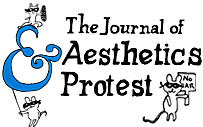
 |
 |
Matias Viegener, David Burns and Austin Young

We began this project by mapping our neighborhood, Silver Lake, going street
by street to identify untapped public resources and cataloging their location.
We set out to only mark sites that involved no trespassing. Right away we
began to speculate on the ethics involved, both on the part of residential
growers and local harvesters.
Free food is available at every time of the year on the streets of Los Angeles. According to the law, if a fruit tree grows on or over public property, the fruit is no longer the sole property of the owner. Fruit trees in particular are highly decorative, and often demand no greater care than any other landscape ornamental. Los Angeles is particularly rich in this respect: bananas, peaches, avocados, lemons, oranges, limes, kumquats, loquats, apples, plums, passion fruit, walnuts, pomegranates and guavas, just to name a few, grow year round in every neighborhood in the city. These fruits ripen at different seasons, so free food is available year round in Los Angeles
Some communities have plantings of decorative fruit trees, such as sour oranges, which look charming but have little use. Public plantings almost never incorporate edible fruit trees, with one exception being the guava trees that shade parts of the Rose Bowl parking lot. Echo Park is known for the quantities of walnut trees at its northern end. Many parks and wild spaces have prickly pear cactus plantings, which yield both young cactus pads for nopales and prickly pear fruit. Accidental fruit trees arise from stray seedlings, an echo of Johnny Appleseed’s mission to populate the American frontier with apples, native to Eurasia. One of the most common street trees in California is the carob tree, source of a nutritious flour that can be used as a cocoa substitute, or the pods can be chewed whole.
Often a resident is reluctant to plant fruit trees because of the litter, fallen fruit that has to be disposed of; likewise, locals are often reluctant to pick food within their grasp because they perceive it to be private property. The slow,“natural”processes of growth and fruition dramatize the shadowy nature of private property. Who does the sun belong to, and rainwater? Why is this lemon in our public space? Is this my banana?
It is no small irony that most Americans eat less than the minimum recommended amounts of fruit and vegetables, even though they are all but free for the taking. Supermarket produce is quite expensive if you count it by caloric content, but the cost of processed food is ridiculous once you factor in the nutritional debit it incurs. Public fruit is more efficient to grow than farmed fruit because it eliminates the cost of transport. Since it is not a mono-crop, as in an orchard of a single variety of apple, there are far less pests and less chemicals required. A further irony is that most of the public fruit in Los Angles is organic, blessed by neglect. Is it safe to eat? Absolutely. Should you worry about car exhaust fumes? No. Those molecules are too large to penetrate the fruit and any smut that lands on the fruit can be washed off.
We call upon the city and urban planning groups to begin plantings that yield edible goods to be shared by the city's citizens. How can these resources be developed to the benefit of all parties? What ethical or contractual obligations are incurred? It has been observed among many hunter-gatherer societies that when people“have more of something than they immediately need, they should carry out their moral obligation to share it out.”
All property owners with suitable sites should be obliged to plant edible trees, or else be taxed to provide food for the poor. Most European cities have communal gardens, which often provide up to half the food of poor families. We need city fruit parks that open their fields to anyone who is hungry. To discourage profiteering, individuals could be limited to taking only as much fruit as they can carry in their hands. This way everyone could give according to their capacities and receive according to their needs.
The utopian promise of California always pictured orange trees with snow-capped mountains in the distance. The new California should have oranges planted between office buildings and bananas in parking lots. Silver Lake is full of the ghosts of old Hollywood: James Dean, Rock Hudson, Judy Garland, Norma Talmadge and Buster Keaton lived here. Their ashes and discards filter through the soil to this day. Dead illusions feed the carnival of fruit that lines our streets.
Over time, we hope to involve more people, especially local activists best equipped to map their own neighborhoods; the life of such a map is quite long, since fruit trees live for decades. While the Internet would seem to be the likeliest venue for such a project, a printed form is essential; the most disenfranchised Angelenos have no access to a computer. Maps must be given to them in person.
When you reap the harvest of your land, you shall not reap all the way to the edges of your field, or gather the gleanings of your harvest. You shall not pick your vineyard bare, or gather the fallen fruit of your vineyard; you shall leave them for the poor and the stranger. Leviticus 19:9-10
Download Fallen Fruit of Silverlake
 |
Map Legend:
Ap apples summer/fall |